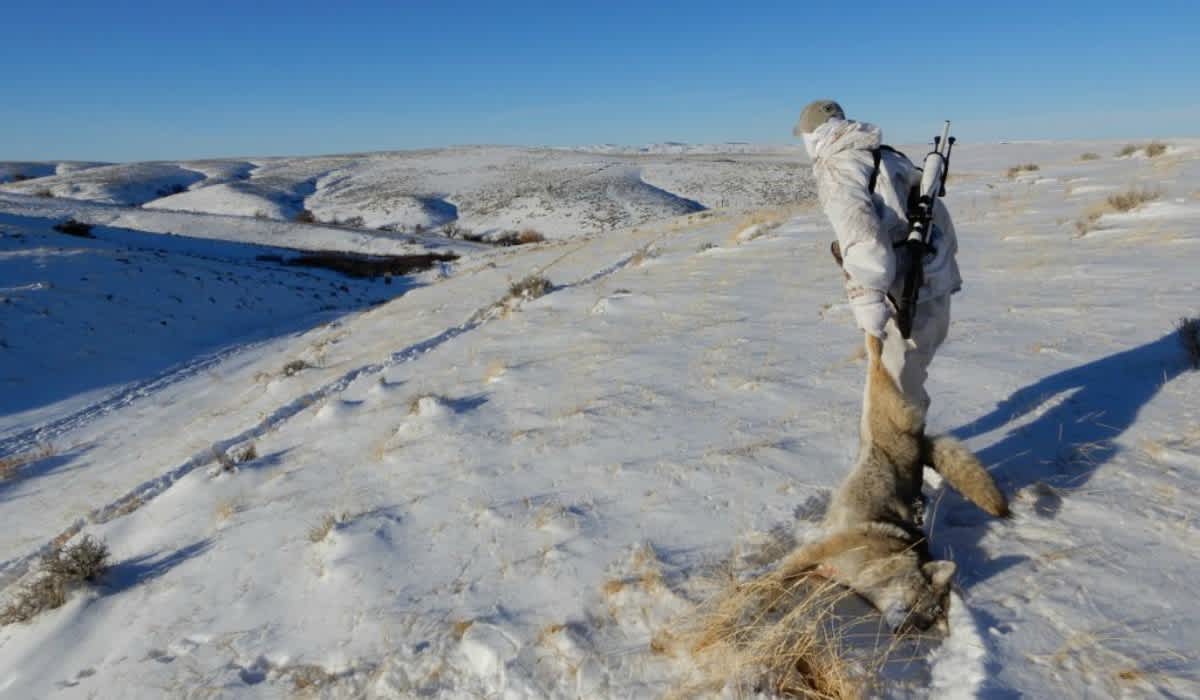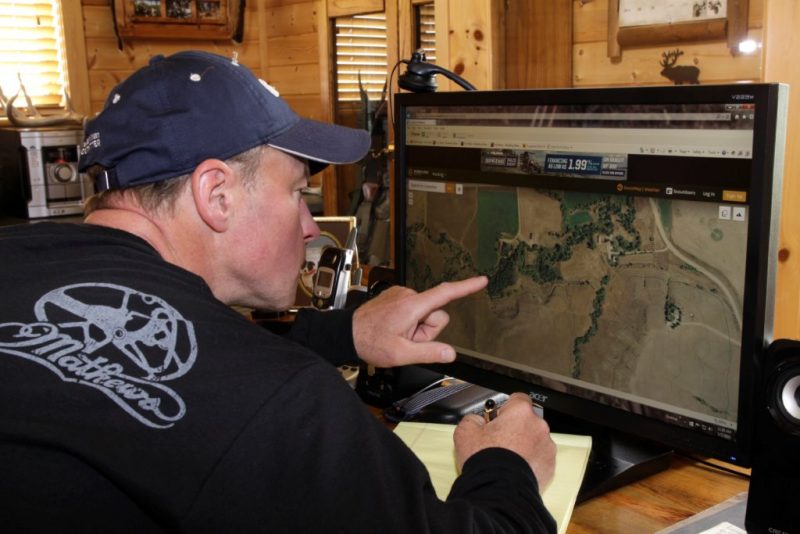Set Up to Make the Coyotes Show
Mark Kayser 02.08.18

Coyotes are as slick as a seasoned pickpocket when they don’t want to be seen. To guarantee a sighting on your next coyote hunt, take into account the terrain as you set up to catch sight of one of nature’s best hide-and-seek champs.
Adolescent coyotes provide a false sense of confidence to you as they trot into calls without a second thought. However, once the crop of teenagers hits the fur shed or advances to grad school, the hide-and-seek game begins. Planning on how win back a title championship in this game depends on your terrain intellect. Coyotes study their homeland, and when teamed with instinctiveness, they understand how to move quickly, confidently and camouflaged through it.
Begin your setup selection at home. Pull up satellite imagery of your hunting area either on Google Earth, or better yet a hunting app such as ScoutLook Weather. Specialized apps like this offer graphic overlays to show future winds, options to make setup notes on the map, and the ability to share hunting notes with predator hunting partners.
Image scrutiny should also include the location of possible coyote hunting grounds and sanctuary cover. Coyotes hunt and bed wherever they please, but rodent-infested grasslands, yarded deer and livestock operations all get additional attention when hunger strikes. The same is true of coyote refuge. They may plop down anywhere, but if they’ve felt hunting pressure, look for them to seek cover a mile or more from bustling byways, holed up in briar thickets, or ascending rugged river breaks for seclusion.
Combining predominant winds with your property breakdown, it’s time to look for high vantage points with open shooting lanes to spot incoming coyotes. Depending on your zip code, these openings could be in the form of woodland openings, cleared utility rights of way, farm lanes, senderos, old forest roads and the likes. The only prerequisite is that the openings give you an ample view for shooting, yet don’t allow a coyote cover to get downwind. Nearly every coyote will angle downwind as it approaches a set, and your setup site should remove as many possibilities for them to get that advantage without a sighting.
Satellites may be able to spot Kim Jong-un’s ongoing missile process, but to see how land can swallow an animal with a shoulder height of less than 2 feet, you’ll need boots on the ground. You can accomplish reconnaissance on your hunts or through scouting trips, but being onsite allows you to survey country with a coyote mindset.
Always gravitate toward high ground for the best advantage in spotting any coyotes. In open farm country, that high ground may be a slight rise of less than 10 feet. It could also include setting up in the hayloft at an abandoned farmstead. Further west, you have options that include high creek banks, ridges and even deserted oil tanks from energy boom periods. In Texas, hunters even park camouflaged hunting vehicles in senderos and climb on top for sniper surveillance. Think high and give the coyotes a reason to step into an opening just outside of downwind detection zones.

Coyotes Like Cover
Savvy coyotes feel more comfortable coming to a call when they can remain close to escape cover. It’s that simple, and your mission is to locate any cover near your setup site that a coyote will follow to your sounds. Thick or rugged cover adjacent to a downwind opening almost guarantees a coyote will show there if one is within earshot.
Some locations shine for this setup scenario, including sagebrush basins out West. In the Midwest and East, you may have to get creative with your site locations. Calling coyotes out of standing crops or wetlands allows them to move confidently except for the final moments if you select a site that forces them out for a downwind whiff.
In wooded settings, you can hopefully call them to a field edge, but more than likely you’ll have to force them across a forested opening, two-track trail or even a brush-hogged path you mowed earlier for whitetail hunting. Don’t overlook food plot setups either because coyotes visit them as regularly as deer for hunting prospects.
One of my go-to locations is to call along creeks or rivers. Instead of focusing on the main tributary, I scout drainages feeding into the main waterway that give me overview dominance, yet wind confidence for approaching coyotes. Coyotes hunt these waterways and oftentimes follow the drainages away from the main cover for bedding security. My calls give them one more reason to take an exit my way.
Coyotes Like Geography
Even if cover is available, coyotes still like to major in geography or acquire a land navigation degree. They have a fondness for following depression, dips, rolls, swales and anything that conceals their slinky form. You might get a coyote to pop up on your elevation if you set up along a high ridge, but pay special attention to any coulee, gully or draw leading to your site.
Oftentimes they’ll abandon the blind spot to get a look or a whiff as they near shooting range, but I can recall several setups where coyotes burst onto the scene within shotgun range because they followed a draw right to the very end. Setting up at the head of a drainage with a downwind opening nearby forces any coyote to eventually pop up in front of you or on a parallel ridge. Your elevation selection should provide a shooting advantage as the coyote tries to circle for scent.
In ridiculously rugged terrain, you need to see every nook and cranny. Don’t overlook the fact that coyotes can climb like a mountain goat, either. Setting up with a terrain restriction behind you, such as a cliff or vertical slope, should again force a coyote into a showing as it attempts concealed circumnavigation for scent superiority.
In addition to a strategic setup site, you have one more option to deploy to discourage a slippery coyote: Bring along a hunting partner and have them watch the backdoor.


